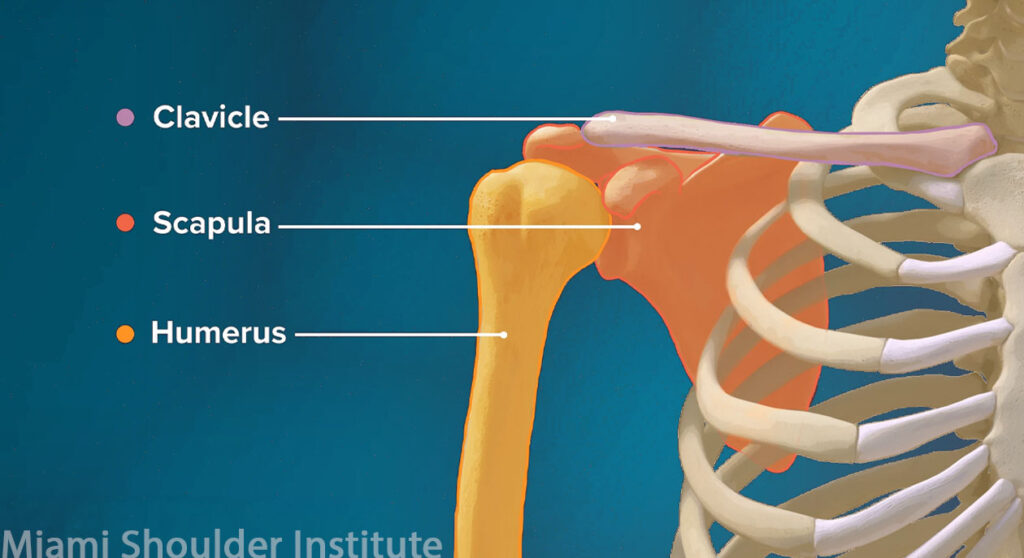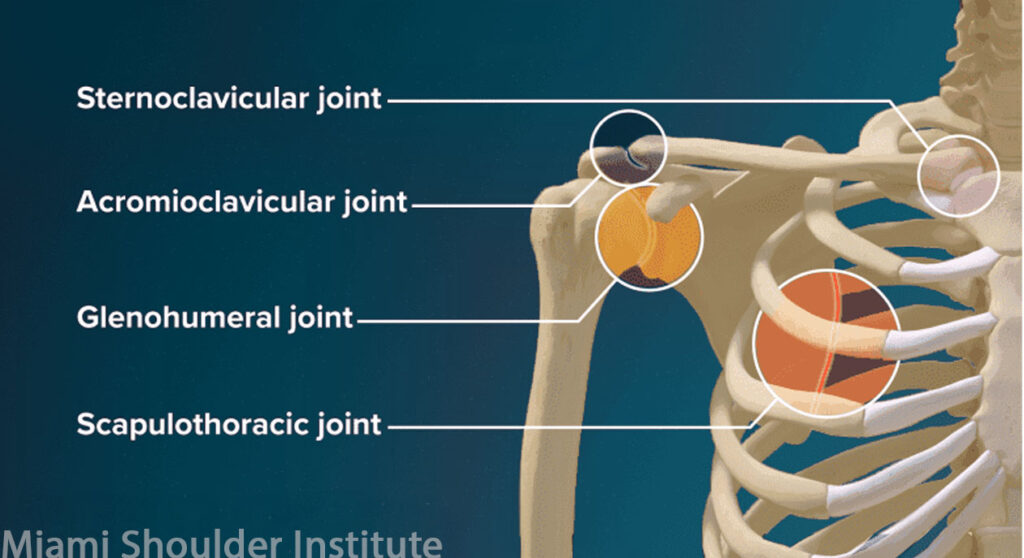Bones provide the rigid supporting structure for the body and limbs. They are living tissues and undergo constant growth and remodeling.
Clavicle (Collarbone): A long bone that connects the sternum (breastbone) to the scapula. It acts as a strut to support the shoulder.
Scapula (Shoulder Blade): A flat, triangular bone that sits on the back of the ribcage. It includes important parts like the acromion (a bony projection that articulates with the clavicle) and the glenoid (the shallow socket that articulates with the humerus).
Humerus (Upper Arm Bone): The long bone of the upper arm, which fits into the glenoid of the scapula to form the glenohumeral joint.


Glenohumeral Joint: This is the main shoulder joint where the humeral head fits into the shallow socket (glenoid) of the scapula, like a ball-and-socket joint. It allows a wide range of motion: abduction (away from the body), adduction (toward the body), flexion (in front of the body), extension (behind the body), and rotation.
Acromioclavicular (AC) Joint: A small joint at the top of the shoulder where the acromion of the scapula meets the clavicle. It plays a role in shoulder elevation.
Sternoclavicular (SC) Joint: Where the clavicle meets the sternum. This joint allows movement of the clavicle, affecting shoulder positioning. This is only true bony articulation between the arm and the body.
Scapulothoracic Joint: Not a true joint but a functional articulation between the scapula and the thoracic ribcage, allowing scapular movement.

Supraspinatus: Positioned on top of the shoulder joint and assists in abduction of the arm.
Infraspinatus: Positioned on the top and back of the joint and externally rotates the shoulder.
Teres Minor: Sits below the infraspinatus on the back of the shoulder joint and aids in external rotation, particularly when the shoulder is in the abducted position.
Subscapularis: Positioned on the front of the joint and internally rotates the shoulder.
Deltoid: A large, triangular muscle covering the shoulder, responsible for arm abduction, flexion, and extension.
Pectoralis Major: A large chest muscle that contributes to shoulder flexion, adduction, and internal rotation.
Trapezius: A large muscle extending from the neck to the shoulder blade, involved in scapular movement.
Latissimus Dorsi: A broad, flat muscle that inserts on the front of the humerus allowing for internal rotation, adduction, and extension of the upper arm.
Teres Major: A smaller muscle positioned above the latissimus that aids in internal rotation and extension of the upper arm.
Rotator Cuff Tendons: Connect the rotator cuff muscles to the humeral head.
Biceps Tendon: The long head of the biceps attaches to the top of the glenoid, aiding shoulder stability. This is largely an accessory tendon and provides approximately 10% of the biceps overall strength.
Glenohumeral Ligaments (Superior, Middle, Inferior): Reinforce the glenohumeral joint capsule.
Coracoclavicular Ligament: Stabilizes the clavicle and acromion.
Coracoacromial Ligament: Forms an arch over the humeral head, limiting superior movement.
The Labrum: Is a ring of cartilaginous tissue that lines the shoulder socket and stabilizes the glenohumeral joint.






Miami Shoulder Institute is dedicated to delivering world-class care with compassion, expertise, and integrity. Your mobility, our mission.